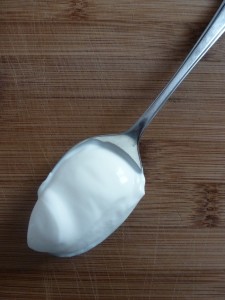 Crème fraîche is similar to sour cream. In fact, they are made by the same process: inoculating dairy with a bacterial culture that converts lactose to lactic acid, which in turn coagulates the proteins in the dairy and thickens the mixture.
Crème fraîche is similar to sour cream. In fact, they are made by the same process: inoculating dairy with a bacterial culture that converts lactose to lactic acid, which in turn coagulates the proteins in the dairy and thickens the mixture.
The main difference between the two products is that crème fraîche is cultured whole cream (about 30% milk fat) while sour cream is made from leaner dairy products (usually about 15% fat). The added fat in crème fraîche gives it two advantages over sour cream. First, it has a more luxurious texture. Second, the fat tempers the acidity, making for a subtler and more rounded flavour.
Making Crème Fraîche at Home
Fresh dairy naturally contains the bacteria that would, over time, turn cream into crème fraîche. The traditional method of production would be to simply incubate that bacteria, and let nature take care of the rest. In the age of pasteurization, we must reintroduce this bacterial strain to the cream. There are several supermarket products that contain this strain. Buttermilk is one.
To make crème fraîche at home, you need only stir one tablespoon of buttermilk into one cup of cream. Cover the mixture and leave it at room temperature for two days. The cream will become quite thick, but as soon as you stir it it will become runny, like double cream. Somehow it develops a nutty flavour, almost like brown butter.
Crème fraîche is perfect for finishing cream soups, as it adds a very mild, pleasing acidity to cut the richness. It being the end of May, with Edgar Farms enjoying its brief few weeks at the Strathcona market, cream of asparagus soup seemed appropriate.
